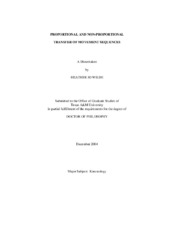| dc.description.abstract | The ability of spatial transfer to occur in movement sequences is reflected upon in theoretical perspectives, but limited research has been done to verify to what extent spatial characteristics of a sequential learning task occur. Three experiments were designed to determine participants’ ability to transfer a learned movement sequence to new spatial locations. A 16-element dynamic arm movement sequence was used in all experiments. The task required participants to move a horizontal lever to sequentially projected targets. Experiment 1 included 2 groups. One group practiced a pattern in which targets were located at 20, 40, 60, and 80° from the start position. The other group practiced a pattern with targets at 20, 26.67, 60, and 80°. The results indicated that participants could effectively transfer to new target configurations regardless of whether they required proportional or non-proportional spatial changes to the movement pattern. Experiment 2 assessed the effects of extended practice on proportional and non-proportional spatial transfer. The data indicated that while participants can effectively transfer to both proportional and non-proportional spatial transfer conditions after one day of practice, they are only effective at transferring to proportional transfer conditions after 4 days of practice. The results are discussed in terms of the mechanism by which response sequences become increasingly specific over extended practice in an attempt to optimize movement production. Just as response sequences became more fluent and thus more specific with extended practice in Experiment 2, Experiment 3 tested whether this stage of specificity may occur sooner in an easier task than in a more difficult task. The 2 groups in Experiment 3 included a less difficult sequential pattern practiced over either 1 or 4 days. The results support the existence of practice improvement limitations based upon simplicity versus complexity of the task. | en |


